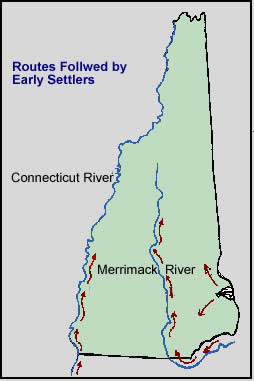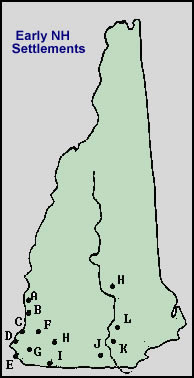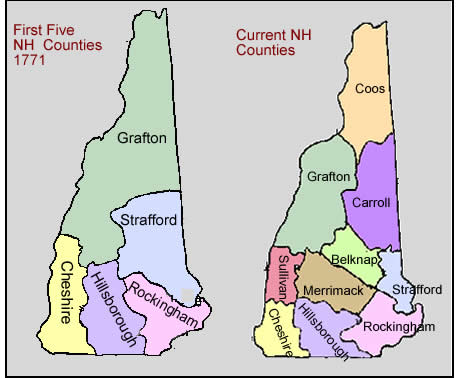Inland Settlements
SUMMARY
 The lesson examines the struggle for survival of the early settlers along the New Hampshire seacoast and the migration of the settlers inland. The lesson examines the struggle for survival of the early settlers along the New Hampshire seacoast and the migration of the settlers inland.
A hundred years after the first seacoast settlements began, some settlers decided to move into the inland wilderness. Because their primary means of travel was along the rivers, towns and villages sprang up along New Hampshire's important rivers. To travel along these inland waterways, the settlers often used canoes.
When settlers did not have a boat for traveling, they would move along the river banks by foot, on horseback, or with the use of an oxcart.
These inland settlers faced many hardships and dangers, one of the most feared being conflict with the Native Americans. The French and English colonies in the New World became involved in a series of wars from 1665-1765. Because New Hampshire was on the frontier between New France and New England, many New Hampshire towns were raided and burned, and some colonists were taken as captives by the Native Americans to Canada.
To protect themselves from these attacks, the settlers devised different kinds of fortifications. In some areas, garrison houses were built. Another method of protection is seen in Old Fort #4, built to protect the people of Charlestown. The most serious attack on that town occurred in 1747.
OBJECTIVES
1. To describe the struggles of the early settlers.
2. To explain why they made little attempt to move inland at first.
3. To describe what difficulties the settlers faced in moving inland.
4. To point out the effect the Indian wars had on these inland settlements.
5. To point out the kinds of defenses that were built to protect against Indian raids.
PRE-VIEWING ACTIVITIES
1. Locate on a map: Nashua, Manchester, Concord, Walpole, Charlestown, Connecticut River, Merrimack River.
2. Why do you think the early settlers decided to move inland?
3. How did the settlers reach their new homes? What kinds of transportation were used? Why were rivers so important for travel?
4. Why do you think there was such hostility between whites and Native Americans? Why did the Native Americans resent the white settlers? What did the whites do to protect themselves?
POST-VIEWING ACTIVITIES
1. Pretend to be a youngster whose family has settled in Portsmouth or Dover. Write a letter to relatives back home in England about life in your town.
2. Draw pictures or make a model of the earliest homes--the garrison houses or the wealthy homes in Portsmouth. Have the children talk about what it would be like to live in these different homes. Have them compare living in these homes to their own, in terms of things like heating, cooking, plumbing.
3. If your community was one of the early inland settlements, find out what town most of the settlers came from. Can you find the route (river, path) they took to reach your town?
4. If an oxcart travelled at a rate of three miles an hour, how long would it have taken settlers to reach your town from a seacoast village, such as Portsmouth? How many miles would they probably travel in a day? How long does it take to travel the same distance today?
5. Make a papier mâché model of a gundalow.
6. Pretend your family is travelling inland along paths and rivers. Keep a journal of your travels.
7. Imagine what it would be like if you had no communication with the outside world (no telephone, daily mail delivery, TV, radio). Don't watch TV or listen to the radio; don't call anyone or write or receive any letters. Report to the class what it felt like. What do you suppose it felt like when this lack of communication was a way of life?
8. Today there are houses called "garrison houses." Perhaps you live in one. How are these houses alike or different from the garrison houses of pre-colonial days?
9. Discuss why the Native Americans took their captives to Canada. Assign students to find out what happened to the captives.
10. Build a model of a fort.
11. Pretend the Native Americans are attacking your town and your family must go into the local fort for protection. Describe what happens.
12. Invite persons to class who have come to New Hampshire in recent years, either from another country or a distant state. Ask them to talk about their experiences. Have they had problems establishing homes? Do they feel accepted? Are they homesick? Why did they make the move?
VOCABULARY
- stockade
- ransom
- portage
- palisade
|
- strategic
- tract
- interior
- shelter
|
- garrison
- gundalow
- elaborate
|
PLACES TO KNOW
PLACES TO VISIT
- John Goffe's Mill, Wayfarer Motor Inn, Bedford
- Ocean Born Mary House, Henniker
- Old Fort No. 4, Charlestown
- Dame Garrison House, 182 Central Avenue, Dover
- Garrison House, 12 Water Street, Exeter
- Daniel Webster Birthplace, Franklin
- Daniel Webster Cottage, North Main Street, Hanover
- Fort Constitution, New Castle -
 Fort Constitution on NH Outlook Fort Constitution on NH Outlook
Learn why the fort may just be the real birthplace of independence. (2:14 min.)
- Old Parsonage, Newington
- Strawbery Banke, P.O. Box 300, Portsmouth
 Strawbery Banke on NH Outlook Strawbery Banke on NH Outlook
NH Outlook talks to historians at Portsmouth's Strawbery Banke about the challenges of colonial life here in the Granite State. (3:34 min.)
- Historic Houses of Portsmouth, Chamber of Commerce, 10 Vaughan St. Mall, Portsmouth
- Powder House, Powder House Point, Exeter
PEOPLE TO KNOW
- Ethan Allen Crawford
- Daniel Pinkham
- Sam and Polly Willey
|
|
MAPS

 |
Key A. No. 4 (Charlestown)
B. No. 3 (Walpole)
C. No. 2 (WestmorelandD)
D. No. 1 (Chesterfield)
F. Uppper Ashuelot (Keene)
G. Lower Ashuelot (Swanzey)
H. Peterborough
I. New Ipswich
J. Dunstable (Nashau)
K. Nutfield (Londonderry)
L. Derryfield (Manchester)
M. Pennycook (Concord) |
U  |
|
WEB RESOURCES
|